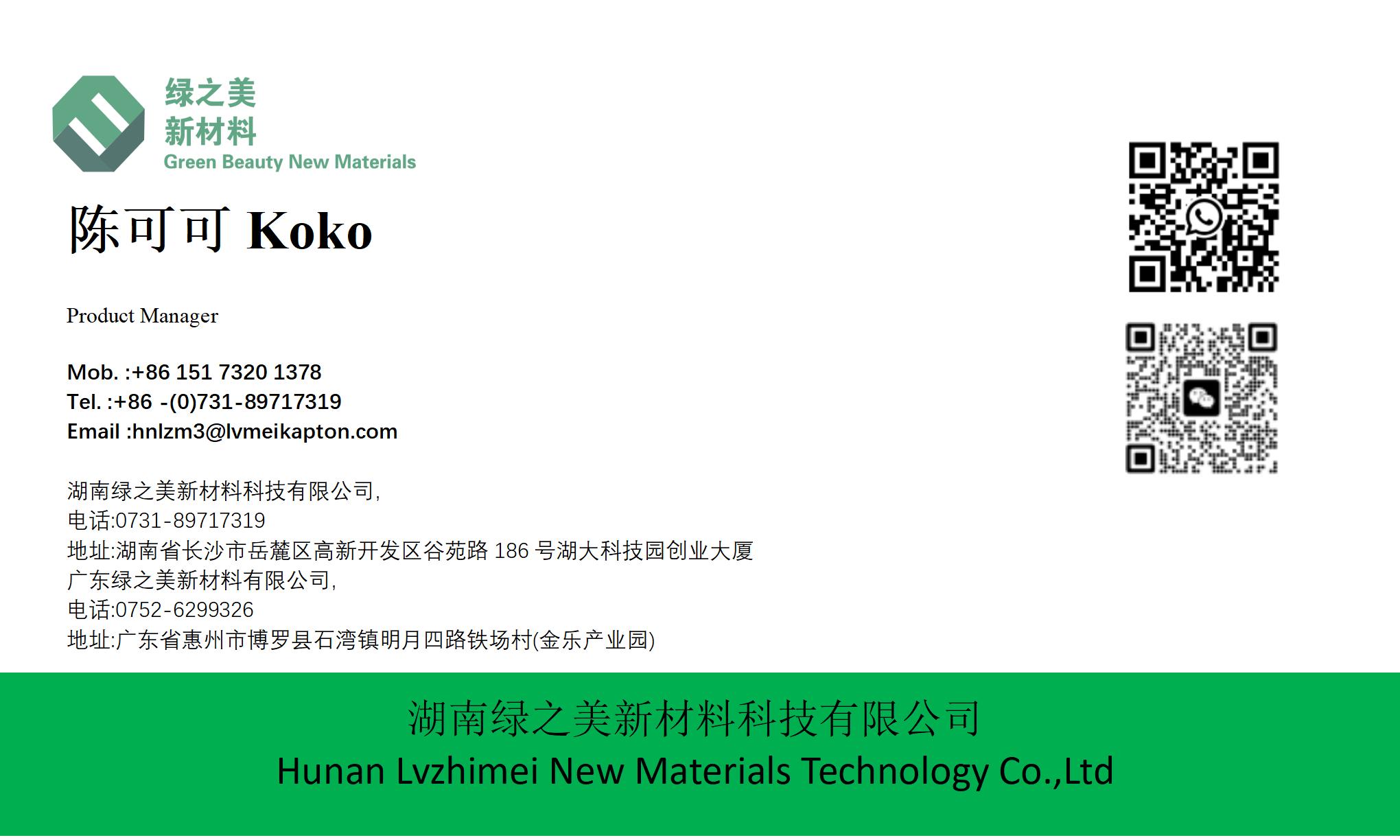hnlzm@lvmeikapton.com
+86 13787123465


Hunan Lvzhimei New Material Technology Co., Ltd.


NameDescriptionContent
When Does PI Material High Temperature Resistant 300 Tape Outperform Alternatives? |https://www.lvmeikapton.com/
Source:
|
Author:Koko Chan
|
Published time: 2025-07-22
|
12 Views
|
Share:
PI tape is fabricated from polyimide, a high-performance material renowned for its exceptional heat resistance, electrical insulation, and mechanical strength. The tape can withstand continuous temperatures up to 300°C without degradation, making it ideal for harsh environments. Its superior electrical insulation properties prevent current leakage, ensuring safety in electrical systems. Additionally, PI tape exhibits high abrasion and tear resistance, coupled with chemical stability against acids, alkalis, and solvents. These characteristics position PI tape as a critical insulation and fixation material in electronics, automotive, aerospace, and other industries.

1. Overview of PI Material High-Temperature Resistance 300 Tape1.1 Basic CharacteristicsPI tape is fabricated from polyimide, a high-performance material renowned for its exceptional heat resistance, electrical insulation, and mechanical strength. The tape can withstand continuous temperatures up to 300°C without degradation, making it ideal for harsh environments. Its superior electrical insulation properties prevent current leakage, ensuring safety in electrical systems. Additionally, PI tape exhibits high abrasion and tear resistance, coupled with chemical stability against acids, alkalis, and solvents. These characteristics position PI tape as a critical insulation and fixation material in electronics, automotive, aerospace, and other industries.
1.2 Application BackgroundIn modern industries, rising temperatures in electronic devices, automotive engines, and aerospace components demand materials with advanced thermal stability. PI tape addresses these challenges by providing reliable insulation and protection for components exposed to extreme heat. For example, in electronic manufacturing, it shields components from thermal stress and short circuits; in automotive engines, it secures wiring harnesses and withstands oil and heat exposure; in aerospace, it ensures cable integrity during rocket launches and space missions.
2. Performance Comparison with Other High-Temperature Tapes2.1 Heat Resistance ComparisonPI tape's continuous operation at 300°C surpasses PET tape (typically ≤150°C) and PTFE tape (≈260°C). While glass fiber tape can withstand up to 400°C, PI tape maintains stability at higher temperatures, offering superior protection in ultra-high-temperature environments.
2.2 Adhesion Force ComparisonPI tape features strong adhesion at high temperatures, preventing detachment and displacement. In contrast, PTFE tape has low surface energy, limiting its adhesion in critical applications. PET tape's adhesion declines significantly above 100°C, making PI tape more reliable for long-term high-temperature fixation.
2.3 Chemical Stability ComparisonPI tape resists most chemicals, including strong acids and alkalis. PTFE tape exhibits similar stability but at a higher cost. PET tape may degrade under corrosive conditions, highlighting PI tape's durability in chemical processing environments.
2.4 Flexibility and Mechanical Properties ComparisonPI tape combines flexibility for complex surfaces with high mechanical strength. Glass fiber tape is rigid and prone to breakage under bending, while PTFE tape has lower mechanical resilience. PI tape's balance of flexibility and strength suits applications requiring both adaptability and durability.
3. Advantages in Different Application Scenarios3.1 Aerospace Industry ApplicationsIn aerospace, PI tape is vital for protecting rocket engine cables and satellite components. For example, SpaceX uses PI tape in engine wiring to withstand combustion heat and vibrations during launches. Its resistance to space radiation and thermal cycling ensures long-term reliability in satellites, reducing failure risks.
3.2 Automotive Industry ApplicationsPI tape excels in engine compartments where temperatures exceed 200°C. It securely fixes wiring harnesses, preventing thermal damage and short circuits caused by oil, dust, and vibrations. Its durability enhances vehicle safety and reduces maintenance costs.
3.3 Electronics Manufacturing ApplicationsPI tape insulates PCB traces, protecting against overheating and short circuits in high-power devices. Its flexibility enables wrapping of intricate components, while its chemical resistance safeguards electronics during manufacturing processes.
4. Accelerated Aging Test Results Analysis4.1 Performance at High TemperaturesAfter 100 hours at 300°C, PI tape retained structural integrity, adhesion, and insulation properties. In contrast, PET tape degraded, and PTFE tape showed reduced mechanical strength.
4.2 Effects of UV and RadiationUV exposure tests revealed PI tape maintaining 95% strength after 2000 hours, outperforming PET tape which cracked and delaminated. Its radiation resistance makes it suitable for outdoor and space applications.
5. Case Studies5.1 SpaceX Case StudySpaceX integrates PI tape in rocket engine wiring to address thermal, vibration, and chemical challenges. Its performance enhances launch reliability and reduces downtime.
5.2 Other Aerospace CompaniesThe European Space Agency employs PI tape for satellite solar panels and antennas, protecting against thermal cycling and space debris impacts.
6. Cost-Benefit Analysis6.1 Price ComparisonPI tape costs (XX–XX/m²) are higher than PET tape (X–XX/m²) but comparable to PTFE tape (XX–XXX/m²).
6.2 Long-term Cost AnalysisDespite higher upfront costs, PI tape's longevity reduces replacement frequency in high-temperature environments, saving total costs over time.
7. Summary and Recommendations7.1 Summary of PI Tape AdvantagesPI tape offers unparalleled high-temperature resistance (300°C), superior adhesion, chemical stability, and mechanical flexibility. It excels in aerospace, automotive, and electronics sectors, ensuring reliability and longevity.
7.2 Material Selection RecommendationsChoose PI tape for:
●
Ultra-high-temperature environments (≥200°C).
●
Applications requiring robust adhesion and chemical resistance.
●
Long-term cost-effectiveness despite initial investment.
Charts and Figures[Insert Table 1: Comparison of Thermal Performance (PI, PET, PTFE, Glass Fiber)][Insert Table 2: Adhesion Force vs. Temperature (Graphical Comparison)][Insert Image 1: SpaceX Rocket Engine Wiring with PI Tape (Illustration)][Insert Image 2: PI Tape Application in Automotive Engine Compartment (Photo)]
ConclusionPI Material High-Temperature Resistance 300 Tape is a pivotal solution for industries facing extreme thermal and environmental challenges. Its balanced performance, durability, and long-term cost benefits make it an indispensable choice for ensuring safety and reliability in critical applications.


Hunan Lvzhimei New Material Technology Co., Ltd.
Quick Links
Product Categories
© 2024 Hunan Lvzhimei New Material Technology Co., Ltd.All Rights Reserved. Designed by Erge
0731 - 89717319
hnlzm@lvmeikapton.com
+86 13787123465
Room 502, Chuangye Building, No186, Guyuan Road, High-Tech District, Changsha, Hunan, China
CONTACT



